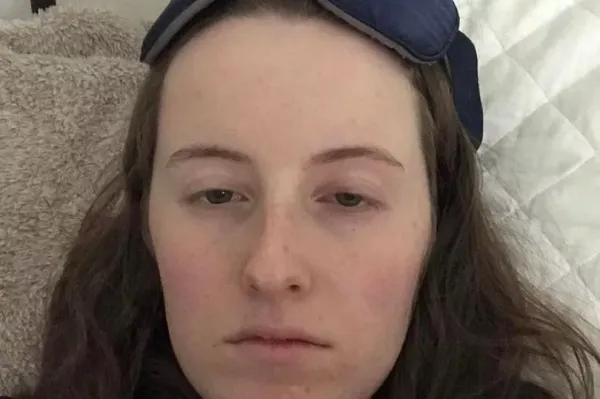
A woman has shared how years of crippling ‘turned her life upside down’ - and says people need to know the condition is much worse than ‘just a’.
Amy Mowbray, now aged 31, lost her job, long-term and her previously active lifestyle after suddenly developing the condition at the age of just 20. She experienced what she now realises was her first attack while working as a waitress at in 2014, when her vision suddenly became distorted and she suffered excruciating head pain. She recalled: “I was working as a waitress, with the tennis on the TV, and I just kept saying to the other people in there - does the screen look funny? Is it going a bit odd?”
READ MORE:

“It was all just starting to move around and it just gradually got worse as I made my way home. By the time I got to my local station I had pretty much lost all my vision. So I had to pretty much scramble to the taxi rank by the station and get a taxi. I just couldn't see. By the time I got home I just remember having this thumping headache, and went to bed not really thinking much of the actual headache at that point, just that this was really scary and no one else was kind of around at the time. I took a couple of paracetamol.”
Six months later, a few days into January, Amy developed a persistent headache. She assumed at first that she might be experiencing a “delayed hangover from New Year's Eve”, but when weeks passed and no pain remedies were working, she started to fear something more could be going on.
“I was taking paracetamol, ibuprofen, all the usual things, but over the next few weeks I was just getting worse and worse”, she said. “Eventually I got to a point one day where I had to turn around on my way to work because I was also getting a lot of sickness in the mornings with it and just generally feeling very unwell and went to the GP and that's how it all kind of went from there. “
“It developed into not only this daily, consistent, unrelenting pain but also having very defined severe attacks within the month as well. So quite quickly, from when I described in that January, I was then having daily background pain and about 20 attack days a month. I was going through what I now know is called the premonitory stage of an attack.
“I was extremely sensitive to noise. I used to have earplugs in while I would eat my dinner, on my own. That's how sensitive I was to sound. And light sensitivity, too - even a crack of a blind or a curtain some days sometimes feels like just piercing your eyeballs”
Her debilitating migraines would go on to last seven years and “impacted every aspect” of her life in a “really devastating way”, leaving her unable to leave her room or even get around the house. The constant pain effectively robbed her of her life as a previously “fun, full of life, happy graduate”, and took with it her love life and her job.
She said: “I was exercising regularly before I just started working in London. I was in a happy relationship, everything was going really well for me and I suddenly was most of the time in bed in a dark room, completely isolated. I had to quit my job. I wasn't able to work anymore. I wasn't able to exercise.
“For a number of years, I struggled to just walk around my house. Movement was really hard, and I found that really hard mentally as someone who was very active beforehand. My long-term relationship broke down. It became a real strain, very difficult for both of us. I had a really good support system with family and friends, but it's still very hard when you're constantly missing out. Everyone else in their 20s is out having a good time, and it felt like I was stuck and everyone else was moving on with their lives.
Forced to abandon her dreams and cut off from her friends, Amy said for a long time she “really grieved the life I thought I was going to have”. What would normally be routine social activities became fraught with difficulty. “I was never someone who had struggled with my mental health before and despite staying, I think, incredibly optimistic and positive during the whole time I had chronic , it really took a hit on me mentally", she said.
“The longer it went on the more anxious I became, because I was just so worried all the time that things would set off my head. I became really fearful about doing anything. Even going to meet a friend for coffee, it didn't happen very often. Even coming over for a cup of tea and sitting with me while I was in bed, I would get really worried and, you know, anxious about that beforehand. So it really did feel like overnight my life was just tipped upside down.”

After seeing multiple doctors and trying almost a dozen different treatments, Amy began to see a clear improvement when she changed the way she approached her condition. She says accepting migraine as a neurological condition, and a part of her life that she can manage, marked a turning point. As well as medication, she has introduced additional changes to her lifestyle that have had a transformative effect, such as neuromodulation devices, supplements, eating more regularly and brain training.
Understanding your 'migraine threshold' and working gradually to increase it is now one of her key tips on her page, the_migraine_life. Sufferers are often confused by how certain triggers, like stress, lack of sleep, sunlight, or skipping lunch sometimes set off a migraine immediately, but other times do not. According to Amy, this is because attacks occur when a combination of stimuli send the body beyond the limit it can tolerate. Keeping a diary your activities and learning when your own personal threshold is passed allows you to live around the condition, rather than trying to eliminate the triggers completely, and it is through treatment and at-home management that you can begin to raise this tolerance, she says.
Amy is now in remission from chronic migraine, and only suffers from infrequent attacks. She’s also living in Cornwall, where she gets to go to the beach often, and is in a “very happy, loving relationship” with a new partner. Amy is back in work, and able to do things that would have been simply unthinkable a few years ago, including getting back onto the tennis court and going on long walks.
According to the There's More to Migraine campaign, symptoms of migraines include sharp, intense pain in the head, as well as in the digestive system, eyes, nose, brain, neck, joints. Some people even experience what are known as 'silent migraines', where there is no headache but nausea, vomiting, and sensitivity to light or sound. Vision loss, flashing lights, blind spots or wavy images that are only perceptible to the person with the migraine are also common.
It's estimated that more than 10 million people are impacted by the neurovascular condition in the UK, and around 190,000 people have a migraine attack every day. Scientists are not yet certain what causes the condition, though it is thought to derive from abnormal brain activity and its impact on nerve signals, chemicals, and blood vessels.
While Amy’s main symptoms centred around head pain, she also suffered neck pain and occipital pain around the back of her head, which she said felt “like electrical zapping”. She admits that before she developed migraines herself, she thought the condition was essentially “just a headache”, and that even when she was diagnosed she remained convinced that doctors had missed “something more serious”, because of how the condition is trivialised.
But she says she now wants to draw attention to just how misunderstood migraines are. Through her social media pages, she is encouraging people who are having any of the signs to read up on the condition, so they can get the best treatment as early as possible and avoid episodic migraines progressing into a more severe disorder like hers. She said: “I think the thing I always really want to highlight is for most people living with migraine, is that there is this gradual progression from people who have it episodically - and it can get worse if it's not well managed and you know you're not getting the right treatment with your doctor. For me it really was like a switch went off in my brain overnight.
“Understanding that when they occur in your specific migraine attack can actually be really help you to actually get control of attacks quicker. Look at other things you can do outside of how you're working with your doctor, like your lifestyle, your routine, things like that. That played a big part in my recovery.”